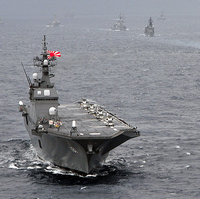On Sunday near Okinawa, the Japanese navy spotted two Chinese warships sailing south into the Pacific. The Chinese vessels were in international waters, but their proximity to Okinawa, which hosts a preponderance of U.S. and Japanese military forces, alarmed Tokyo. As a courtesy, navies traditionally announce their routine cruises in advance, particularly when one nation's ships might pass close to another's territory.
Sunday's infraction of that protocol was not the first for China. Just three months prior, two Japanese warships patrolling around Okinawa had discovered an unannounced flotilla of at least 10 Chinese vessels, including two submarines. During the encounter, a Chinese helicopter buzzed one of the Japanese ships, eliciting a formal protest from Tokyo.
These and other recent incidents seem to portray China as a maritime aggressor among nations apparently unprepared to counter any move by Beijing. But Japan, for one, is quietly enhancing military capabilities that themselves pose a serious threat to the fast-growing Chinese navy. Indeed, for all China's rapid naval expansion, the strategic scales in the Pacific still tilt in favor of the U.S. and Japan -- and should continue to do so, provided the ruling Democratic Party of Japan maintains Japan's current course.

